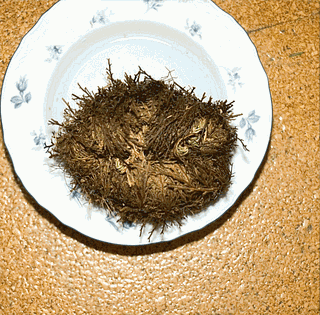Resurrection Plants on:
[Wikipedia]
[Google]
[Amazon]
A resurrection plant is any  Examples include:
* ''
Examples include:
* ''
poikilohydric
Poikilohydry is the lack of ability (structural or functional mechanism) to maintain and/or regulate water content to achieve homeostasis
In biology, homeostasis ( British also homoeostasis) (/hɒmɪə(ʊ)ˈsteɪsɪs/) is the state of steady i ...
plant that can survive extreme dehydration, even over months or years.
 Examples include:
* ''
Examples include:
* ''Anastatica hierochuntica
''Anastatica'' is a monotypic genus of plants in the family ''Brassicaceae'' containing the single species ''Anastatica hierochuntica''. The plant is a small gray annual herb that rarely grows above high, and bears minute white flowers. It is a ...
'', also known as the Rose of Jericho, a plant species native to deserts of North Africa
* ''Asteriscus'' (plant);
* '' Boea hygrometrica'',
* '' Craterostigma'', members of the Linderniaceae/Scrophulariaceae with snapdragon-like flowers
* '' Haberlea rhodopensis''
* ''Lichen
A lichen ( , ) is a composite organism that arises from algae or cyanobacteria living among filaments of multiple fungi species in a mutualistic relationship.desiccation
Desiccation () is the state of extreme dryness, or the process of extreme drying. A desiccant is a hygroscopic (attracts and holds water) substance that induces or sustains such a state in its local vicinity in a moderately sealed container.
...
,
* ''Mesembryanthemum
''Mesembryanthemum'' is a genus of flowering plants in the family Aizoaceae; like many members of this family, it is characterized by long-lasting flower heads. Flowers of ''Mesembryanthemum'' protect their gametes from night-time dews or frosts ...
'', the plant can revive within a short period of time after a drought
* ''Myrothamnus flabellifolius
''Myrothamnus flabellifolius'' is a plant species in the genus ''Myrothamnus
''Myrothamnus'' is a genus of flowering plants, consisting of two species of small xerophytic shrubs, in the southern parts of tropical Africa and in Madagascar. '' ...
'', a plant species native to Southern Africa
* ''Pleopeltis polypodioides
''Pleopeltis polypodioides'' (syn. ''Polypodium polypodioides''), also known as the resurrection fern, is a species of creeping, coarse-textured fern native to the Americas and Africa.
Description
The evergreen fronds of this fern are 25 c ...
'', also known as resurrection fern
* ''Ramonda serbica
''Ramonda serbica'', also known as Serbian ramonda and Serbian phoenix flower, is a species in the family Gesneriaceae. It is one of the few European representatives of this family, found in Albania, Bulgaria, Greece, North Macedonia and Serbia. ...
'', a species in the family Gesneriaceae
* '' Selaginella lepidophylla'', a plant species native to North America, Central and South America, and sold as a novelty
* ''Tillandsia
''Tillandsia'' is a genus of around 650 species of evergreen, perennial flowering plants in the family Bromeliaceae, native to the forests, mountains and deserts of northern Mexico and south-eastern United States, Mesoamerica and the Caribbean to ...
''
* '' Xerophyta'', a monocotyledonous genus typically occurring on rock outcrops in Southern African grasslands
Certain resurrection plants have long been sold in their dry, "lifeless" form as curiosities. This custom was noted by many 19th century authors, and continues today.
In December, 2015, resurrection plants were featured in a TED talk
TED Conferences, LLC (Technology, Entertainment, Design) is an American-Canadian non-profit media organization that posts international talks online for free distribution under the slogan "ideas worth spreading". TED was founded by Richard Sau ...
given by Professor Jill Farrant
Jill Farrant, professor of molecular and cell biology at the University of Cape Town, South Africa, is a leading expert on resurrection plants, which 'come back to life' from a desiccated, seemingly dead state when they are rehydrated.
Research ...
, Molecular and Cell Biology, University of Cape Town
The University of Cape Town (UCT) ( af, Universiteit van Kaapstad, xh, Yunibesithi ya yaseKapa) is a public research university in Cape Town, South Africa. Established in 1829 as the South African College, it was granted full university statu ...
, South Africa
South Africa, officially the Republic of South Africa (RSA), is the southernmost country in Africa. It is bounded to the south by of coastline that stretch along the South Atlantic and Indian Oceans; to the north by the neighbouring countri ...
, who performs targeted genetic modification
Genetic engineering, also called genetic modification or genetic manipulation, is the modification and manipulation of an organism's genes using technology. It is a set of technologies used to change the genetic makeup of cells, including t ...
of crop plants to make them tolerate desiccation
Desiccation () is the state of extreme dryness, or the process of extreme drying. A desiccant is a hygroscopic (attracts and holds water) substance that induces or sustains such a state in its local vicinity in a moderately sealed container.
...
by activating genes that are already there but not natively expressed in response to drought
A drought is defined as drier than normal conditions.Douville, H., K. Raghavan, J. Renwick, R.P. Allan, P.A. Arias, M. Barlow, R. Cerezo-Mota, A. Cherchi, T.Y. Gan, J. Gergis, D. Jiang, A. Khan, W. Pokam Mba, D. Rosenfeld, J. Tierney, an ...
.
See also
*Dehydration
In physiology, dehydration is a lack of total body water, with an accompanying disruption of metabolic processes. It occurs when free water loss exceeds free water intake, usually due to exercise, disease, or high environmental temperature. Mil ...
* Cryptobiosis
* Anhydrobiosis
Cryptobiosis or anabiosis is a metabolic state of life entered by an organism in response to adverse environmental conditions such as desiccation, freezing, and oxygen deficiency. In the cryptobiotic state, all measurable metabolic processes sto ...
* Hygrochasy
References
Plant physiology Resurrection plants {{botany-stub